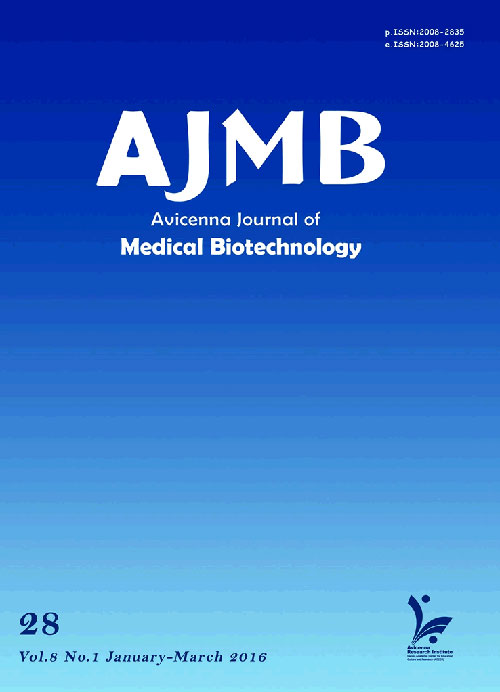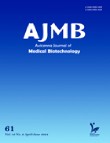فهرست مطالب

Avicenna Journal of Medical Biotechnology
Volume:8 Issue: 1, jan-mar 2016
- تاریخ انتشار: 1394/10/25
- تعداد عناوین: 8
-
-
Page 1The biotechnology industry has grown rapidly in recent years, doubling in size between 2004 and 2014. Much attention is given to the potential of the biotechnology industry, from drugs and environmental products currently in the pipeline. These products have the potential to generate tremendous opportunities for society, by improving the quality of health care and producing a cleaner environment. Over the past few decades biotechnology sometimes described as the oldest profession in the world has evolved into a modern technology without which medical progress would be scarcely imaginable. Modern biotechnology plays a crucial role both in the elucidation of the molecular causes of disease and in the development of new diagnostic methods and better targeted drugs. Diagnosis and treatment are thus becoming increasingly intertwined. When a disease, rather than being diagnosed on the basis of more or less vague signs and symptoms, can be detected on the basis of molecular information, the possibility of successful treatment depends largely on what diagnostic techniques are available. Biotechnology is an important component of the worldwide economy, and could take on an increasingly significant role as the industry continues to develop. The economic impact of biotechnology as a distinct industry is currently difficult to evaluate because of the manner in which data is collected; however, it is possible to calculate the combined impact of the biotech and pharmaceutical industries
-
Pages 2-8BackgroundThe Definitive Endoderm (DE) differentiation using the undefined media and non-human feeders can cause contaminations in the generated cells for therapeutic applications. Therefore, generating safer and more appropriate DE cells is needed. This study compared five different methods to establish an appropriate method for inducing an efficient DE differentiation from Human Induced Pluripotent Stem Cells (hiPSCs) on an appropriate feeder in a more defined medium.MethodsHuman Induced Pluripotent Stem Cells (hiPSCs) were cultured on inactivated feeders. Passaged hiPSCs, without feeder, were incubated for three days with Activin-A and different endodermal differentiation media including 1-FBS, 2-B27, 3-ITS and albumin fraction-V, 4-B27 and ITS and 5-like the third medium. The feeder cells in the first four methods were Mouse Embryonic Fibroblasts (MEFs) and in the fifth method were human adult bone marrow Mesenchymal Stem Cells (hMSCs). DE markers FOXA2, SOX17 and CXCR4 and also pluripotency marker OCT4 were evaluated using qRT-PCR, as well as FOXA2 by the immunocytochemistry.ResultsQRT-PCR analysis showed that after three days, the expression levels of DE and pluripotency markers in the differentiated hiPSCs among all five groups did not have any significant differences. Similarly, the immunocytochemistry analysis demonstrated that the differentiated hiPSCs expressed FOXA2, with no significant differences.ConclusionDespite this similarity in the results, the third differentiation medium has more defined and cost effective components. Furthermore, hMSC, a human feeder, is safer than MEF. Therefore, the fifth method is preferable among other DE differentiation methods and can serve as a fundamental method helping the development of regenerative medicine.Keywords: Endoderm, Induced pluripotent stem cells, Mesenchymal stem cells
-
Pages 9-15BackgroundThe presence of rennin-angiotensin components in mammalian ovaries and their involvement in ovarian physiology have been established. In the present study, effects of angiotensin II (Ang II) on sodium-potassium adenosine triphosphatase (Na+/K+/ATPase) expression and development of sheep embryos was evaluated.MethodsThe abattoir-derived Cumulus Oocyte Complexes (COC) were randomly allocated into three experimental groups; group I) in vitro Maturation (IVM) of oocytes in the presence of Ang II followed by in vitro fertilization (IVF)/in vitro Culture (IVC) (IVM group), group II) IVM/IVF of oocytes followed by IVC wherein the embryos were exposed to Ang II on day 4 of IVC (D4 group), and group III) IVM/IVF and IVC of oocytes without any angiotensin (Control). The blastocyst and hatching rates were recorded on days 6 to 8. Day 8 embryos were immunostained with primary and secondary antibodies against Na+/K+/ATPase α1 and β1 subunits.ResultsAddition of Ang II during IVM and IVC significantly increased the hatching rate of blastocysts on day 8 compared to the control. The trophectoderm and total blastocyst cells’ numbers were significantly increased by addition of Ang II to the IVM and IVC media, though the expression of Na+/K+/ATPase α1 and β1 subunits were positively influenced by the addition of Ang II on day 4 (D4 group).ConclusionIn conclusion, it seems Ang II through positive effects on embryos, expressed as the greater hatching rate and blastocyst cell number, could increase the sheep embryo developmental rate. These improvements might be partly related to the greater expression of Na+/K+/ATPase α1 and β1 subunits when Ang II was added during IVC.Keywords: Angiotensin II, Development, Embryo, Expression, Na+, K+, ATPase, Sheep
-
Pages 16-22BackgroundEscherichia coli (E. coli) is the most extensively used host for the production of recombinant proteins. However, most of the eukaryotic proteins are typically obtained as insoluble, misfolded inclusion bodies that need solubilization and refolding. Reteplase as a highly disulfide-bonded recombinant protein is an example of difficult to express protein in E. coli.MethodsIn this study, a codon optimized reteplase gene was synthetically prepared and cloned under the control of an IPTG inducible T7 promoter. The vector was simultaneously transformed and expressed in three different E. coli strains. The ability of strains for expression of this recombinant pharmaceutical was compared. Also, an attempt was made to increase the soluble production of reteplase in SHuffle T7 E. coli with alterations of expression condition like temperature, inducer concentration and oxygen supply.ResultsHigh amounts of reteplase were expressed as inclusion bodies in all three strains. BL21 (DE3) showed the highest level of expression in inclusion bodies followed by Rosetta-gami (DE3) and Shuffle T7. Changes of expression conditions were insufficient for soluble expression of reteplase in SHuffle T7 as a genetically engineered host for production of disulfide bonded proteins.ConclusionThe oxidizing cytoplasm of Rosetta-gami and Shuffle T7 in addition to alterations of cultivation parameters could not result in soluble production of reteplase, although the inclusion bodies produced in these two strains might increase the rate of refolding procedure likely due to formation of folding intermediates.Keywords: Escherichia coli, Recombinant proteins, Reteplase, Tissue Plasminogen Activator
-
Pages 23-28BackgroundVascular Endothelial Growth Factor (VEGF) is a coordinate regulator of physiological angiogenesis during embryogenesis, skeletal growth and reproductive functions. There are several types of VEGF, including VEGF165. VEGFs stimulate endothelial cell growth, angiogenesis, and capillary permeability. Low induction temperature is a major factor for expression of the recombinant VEGF165 in soluble form. The purpose of this study was cloning and optimization of soluble vascular endothelial growth factor165 expression in Escherichia coli (E. coli).MethodsIn this study, total RNA of HeLa cell [cervix epithelium] was extracted. The VEGF165 gene was amplified by reverse transcription polymerase chain reaction (RT-PCR), and then VEGF165 was subcloned into prokaryotic expression vectors pET-32a(+) and transformed into BL21 (DE3) E. coli strain. VEGF165 expression was optimized by fine adjustments such as induction time and incubation temperature. VEGF165 was analyzed by DNA sequencing prior to expression and the protein was further characterized by SDS-PAGE and immunoblotting using His•tag specific polyclonal antibody.ResultsOur results demonstrated that VEGF165 was successfully cloned and expressed in pET-32a(+) vector. Optimization of the expression procedure showed that, induction by 1 mM IPTG at OD600=0.7 and overnight incubation at 22oC resulted in the highest expression levels of soluble VEGF165.ConclusionIn this study, the expression of VEGF165 in a high soluble level was successfully cloned and optimized.Keywords: Expression, Inclusion bodies, Recombinant, VEGF165 protein
-
Pages 29-35BackgroundMarine organisms provide appreciable source of novel bioactive compounds with pharmacological potential. There is little information in correlation with anti-cancer activities of brittle star. In the present study, anti-neoplastic efficacy of Ophiocoma erinaceus methanol extract against human cervical cancer cells was investigated.MethodsThe HeLa cells were cultured and exposed to brittle star methanol extract for 24 and 48 hr. The anti-proliferative properties were examined by MTT assay and the type of cell death induced was evaluated through morphological changes, flow cytometry, Annexin kit and caspase assay. To assess the anti-metastatic activity, wound healing assay was conducted and photographs were taken from the scratched areas. Further, to understand molecular mechanism of cell apoptosis, the expression of Bax was evaluated.ResultsThe morphological analysis and MTT assay exhibited that the brittle star methanol extract can exert dose dependent inhibitory effect on cells viability (IC50, 50 μg/ml). Flow cytometry and fluorescence microscopy demonstrated increment of sub-G1 peak, early and late apoptosis in HeLa treated cells. Wound healing migration assay showed that brittle star extract has anti-neoplastic efficacy by inhibiting cell migration. Caspase assay and RT-PCR analysis revealed that brittle star methanol extract induced caspase dependent apoptosis in HeLa cells through up-regulation of caspase-3 followed by up-regulation of Bax gene which is a hallmark of intrinsic pathway recruitment.ConclusionThese results represented further insights into the chemopreventive potential of brittle star as a valuable source of unknown therapeutic agents against human cervical cancer.Keywords: Apoptosis, Brittle star, Uterine cervical neoplasms
-
Pages 36-41BackgroundPiwi-interacting RNAs (piRNAs) are small non-coding RNAs (ncRNAs), with a length of about 24-32 nucleotides, which have been discovered recently. These ncRNAs play an important role in germline development, transposon silencing, epigenetic regulation, protecting the genome from invasive transposable elements, and the pathophysiology of diseases such as cancer. piRNA identification is challenging due to the lack of conserved piRNA sequences and structural elements.MethodsTo detect piRNAs, an appropriate feature set, including 8 diverse feature groups to encode each RNA was applied. In addition, a Support Vector Machine (SVM) classifier was used with optimized parameters for RNA classification. According to the obtained results, the classification performance using the optimized feature subsets was much higher than the one in previously published studies.ResultsOur results revealed 98% accuracy, Mathew’ correlation coefficient of 98% and 99% specificity in discriminating piRNAs from the other RNAs. Also, the obtained results show that the proposed method outperforms its competitors.ConclusionIn this paper, a prediction method was proposed to identify piRNA in human. Also, 48 heterogeneous features (sequence and structural features) were used to encode RNAs. To assess the performance of the method, a benchmark dataset containing 515 piRNAs and 1206 types of other RNAs was constructed. Our method reached the accuracy of 99% on the benchmark dataset. Also, our analysis revealed that the structural features are the most contributing features in piRNA prediction.Keywords: Piwi, interacting RNAs (piRNAs), RNA, Support Vector Machines (SVM)
-
Pages 42-45BackgroundThe use of selective and differential plating media is a simple method for the isolation of Salmonella spp. Recently, there has been a general move toward molecular methods of Salmonella detection and typing.MethodsA total of 1200 different specimens collected from human and animal sources were involved in his study. 600 stool specimens from patients suffering from diarrhea and 600 specimens from gall bladder (bile) of cattle from Al-Diwaniya slaughter house, Iraq were used. Salmonella spp. were isolated and identified using bacterial culturing on selective media and colonies were tested by API 20Eand then serotyping through polyvalent antisera and conformation by Polymerase Chain Reaction (PCR). PCR was used to detect ompC gene encoding biosynthesis of outer membrane protein C of Salmonella genus.ResultsThe results revealed that the rate of Salmonella isolates was 0.5% (3/600) from human and 1% (6/600) from animals. The PCR technique revealed that 9 isolates of Salmonella spp. harbored ompC gene. The results of this study revealed that the PCR technique had a high specificity in detection of Salmonella spp., in comparison to culture and biochemical test, Mini API 20 E and serological tests. The present study found no significant differences between human and animal isolates.ConclusionDetection of ompC gene is a good method for detection of Salmonella species isolated from clinical specimens. It has a high specificity in comparison with other tests, with its advantages of greater speed and effectiveness than conventional detection methods.Keywords: Detection, Gene, Polymerase chain reaction, Salmonella


